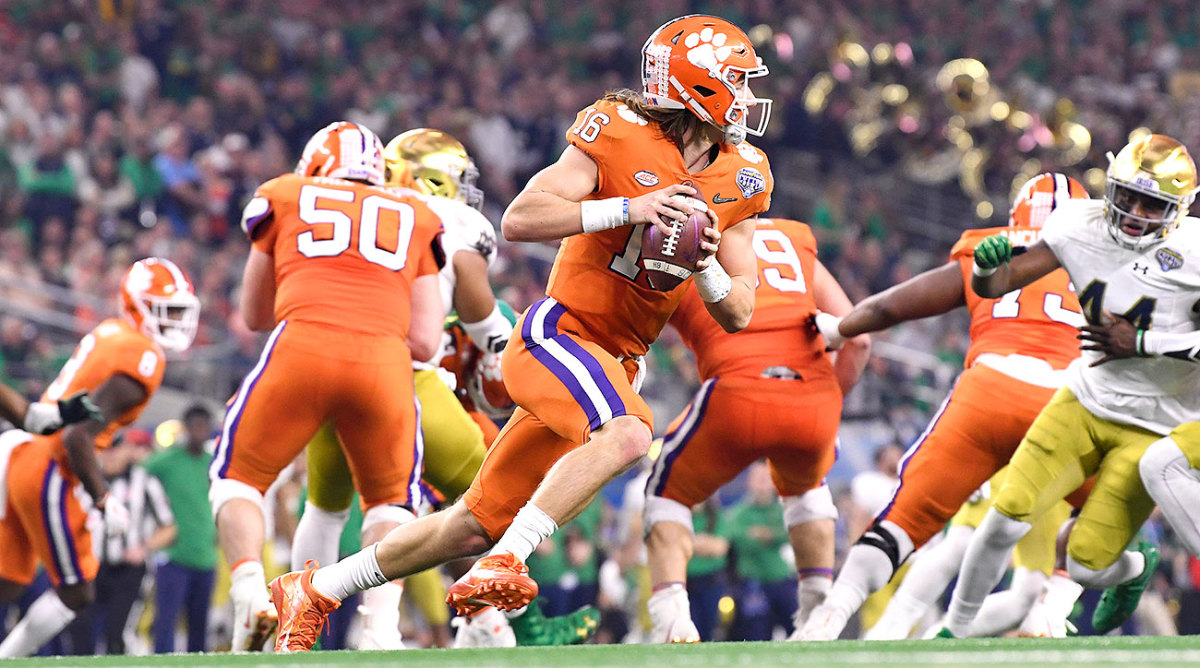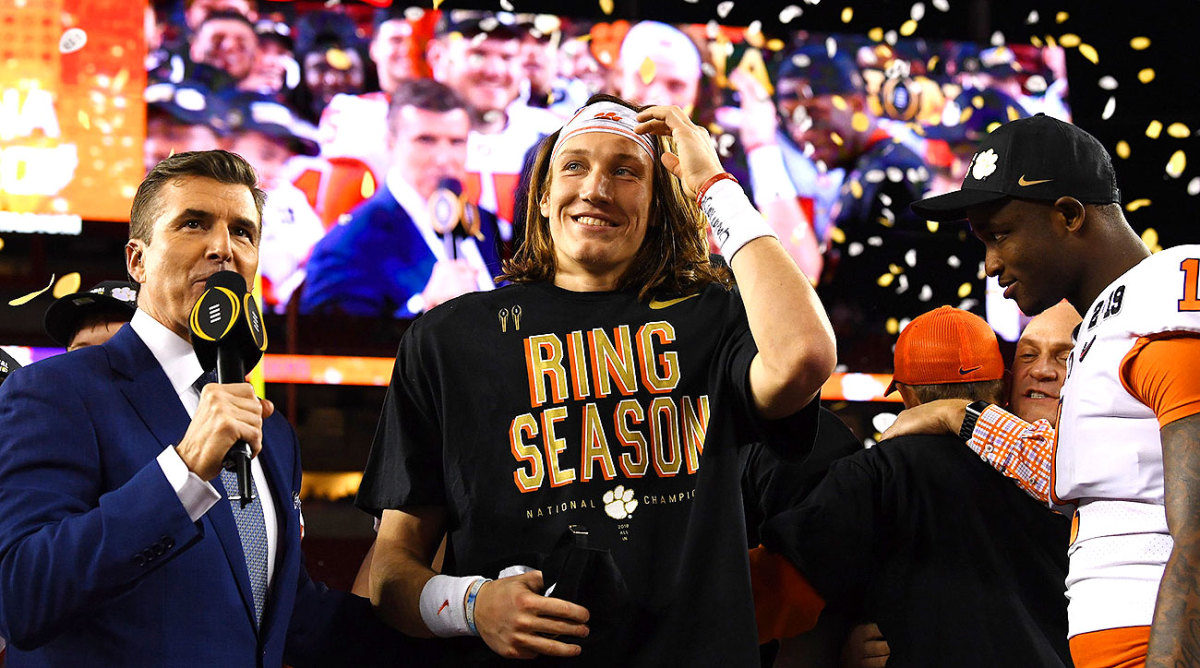The NFL Awaits the Arrival of Trevor Lawrence

You probably don’t remember the 22-yard field-goal attempt that Cleveland’s Phil Dawson missed against St. Louis (now Los Angeles) on Nov. 13, 2011, which led to a Rams’ 13-12 victory against the Browns. But those who survived the overhaul that cost then-St. Louis GM Bill Devaney and coach Steve Spagnuolo their jobs two months later do—and for good reason.
If Dawson makes that kick, the Rams draft Andrew Luck.
Instead, that game was one of two St. Louis wins in 2011. Had that chip shot split the uprights, the Rams would have finished with a 1-15 record—worse than the Colts—and landed the first pick. I’ve been told on good authority that first-year GM Les Snead and coach Jeff Fisher then would’ve traded Sam Bradford and taken the Stanford prodigy atop the 2012 draft. The implications to follow? Staggering, making this an ultimate NFL what if.
Were it to go down that way, Robert Griffin III likely would’ve been a Colt, and Mike Shanahan probably takes Ryan Tannehill with the sixth pick of the 2012 draft. Maybe then, with Luck and a haul of picks back for Bradford, Fisher winds up winning in St. Louis. Maybe he wins enough to keep the team from moving to Los Angeles Maybe, in this scenario, Griffin and Shanahan’s respective fates are different.
We can keep going... If Luck had declared for the draft in 2011, he goes first overall to Carolina—and then Cam Newton winds up in Denver, Von Miller in Buffalo. What, then, happens to Peyton Manning? How about the domino effect on the top 11 picks of the ’11 draft, which counts seven future Hall of Fame candidates within its ranks?
That’s the power a young Luck had as he played out his Stanford career. Rarely does a single player carry that kind of influence.
But we’re about to see another one again.

Talking with quarterback gurus and NFL scouts, I looked for someone—anyone—to tell me that Trevor Lawrence is overhyped. The Clemson QB had a starry, 11-start ascent as a true freshman last season, which culminated in a 347-yard evisceration of Nick Saban’s Alabama in the 2019 College Football Playoff National Championship.
Every single response was, in essence, a flat no.
“There’s nothing he can’t do,” says former NFL quarterback Trent Dilfer, who coached Lawrence in Elite 11. “The only question is if he’ll continue to do it. It’s hard to temper your excitement, because he checks every single box. Confidence, intelligence, athleticism, smarts, twitch, arm strength, power—you go through all the boxes, he’s nines or 10s. It’s like Andrew Luck.”
“He’s perfect,” ex-NFL quarterback/current mechanics coach Jordan Palmer says.
Lawrence likely would’ve been the first pick in this year’s draft—and probably even next year—if he were eligible. He will almost certainly be the top pick in 2021, if he declares after his true junior season at Clemson.
Luck managed similar hype throughout his college career. After his breakout redshirt freshman year at Stanford, some NFL scouts think Luck would have been drafted before Bradford as the first pick in the 2010 draft, had he been eligible. The Panthers would’ve taken him first overall in ’11 if he had declared. The Colts finally made him the No. 1 pick in ’12.
Yes, we’ve heard these narratives before with guys like Jimmy Clausen (once crowned the LeBron James of football), Matt Barkley, Christian Hackenberg and Josh Rosen. The difference here is the reality of Lawrence’s physical gifts, and the fact that, at 19 years old, he’s already delivered on his potential with a national title, and a showcase performance on a huge stage against a generational defensive coach.
All of this is to say—yes, the NFL is already paying attention to Lawrence, and, yes, as was the case with Luck, Lawrence’s presence will hover over (at least) the next two draft cycles.
So how will this impact the next two NFL seasons? In more ways than you might think…
First, there’s the obvious: even with a very promising QB class—headed by Alabama’s Tua Tagovailoa and Oregon’s Justin Herbert—coming down the pike, the urgency to draft a quarterback might be quelled to some degree. Next year, if a team is in the position that, for example, Miami was in this offseason, they may not be overly motivated to move up for a quarterback in the 2020 draft, knowing what could be coming 12 months later.
Second, there are the teams you may not be thinking of as quarterback-needy now who emerge as contenders for Lawrence. We saw this to an extent this year, with the Cardinals ditching Rosen for Kyler Murray, a player with whom new head coach Kliff Kingsbury was smitten. Imagine if there was a player who won over the affection of far more teams—when it comes to Lawrence, that’s where this could go. That also means it would behoove young quarterbacks like Daniel Jones, Dwanye Haskins, Josh Allen and Lamar Jackson to keep their teams out of the upper reaches of the 2021 draft order.
“The way the league is now, it’s not prohibitive to get out of a first-round rookie contract,” one NFC national scout says. “So as I see it, the Giants are not out of the Trevor Lawrence sweepstakes. The Redskins aren’t either. The fact is, very few would be out, based on what he could be.”
Third, rebuilding teams may potentially try and stockpile assets in the spring of 2020 to prepare for a run at Lawrence via trade in ’21. Chances are, it will take a war chest of assets to convince the team picking first overall to give up that spot.
Fourth, consider that the end of the 2020 season could get pretty wild. You may remember that the 2011 Colts started 0-13 before winning two in a row that December, which jeopardized their draft position. Dan Orlovsky, Indianapolis’s starting quarterback at that point, recalls that the Jim Caldwell-led coaching staff didn’t address the elephant in the room with the players. Part of their reasoning was to focus the team on winning the game. The other part? They really didn’t have to. The players knew what everyone on the outside was thinking—that losing would be better for the franchise than winning.
Almost eight years later, it’s hard to argue with that logic.
“I remember the conversation being ‘What’s best to have happen —win and likely not get No. 1 pick and then probably keep Peyton [Manning], or lose and lock up the pick and get Luck?’” Orlovsky says now. “That was really that narrative nationally. And we understood that as players—it was a really unique situation.”
Unique … maybe until now. Apprised of Palmer’s comment on Lawrence, Orlovsky affirmed it: “He doesn’t have a flaw on or off the field.”

All that said, there is a pesky caveat. Lawrence has to continue to play at this level.
Expectations will be out of control. He finished his true freshman season with a 30-4 TD-INT ratio, and only threw two picks after being named starter in late September, two weeks before his 19th birthday. He still has yet to throw multiple interceptions in a college game, and he threw none in the college football playoffs. And you can imagine the scrutiny he’ll be under, with the anointing oil already running low.
He made jaw-dropping throw after jaw-dropping throw at the end of last year, and most people turning on the TV to watch Clemson this fall and next will do so in anticipation of a continuation of that. Bottom line, the bar is very, very high.
Lawrence knows that. Our Kalyn Kahler caught up with him at the Manning Passing Academy at the end of June and asked him about it. At least on the surface, he’s pretty aware of the potential that NFL scouts see.
“I think pressure is whatever you make of it,” Lawrence told Kahler. “If you put it on yourself, then obviously you are going to feel that pressure. But if you go by your expectations and what your team wants, then I think you're fine. Don't worry about what other people think and what they say.
The flip side is woven right into what he said—Dabo Swinney has built the kind of powerhouse in South Carolina that insulates its stars with talent and resources. The Tigers will win a bunch of games getting off the bus. Lawrence will be throwing to likely 2020 first-round pick Tee Higgins this year, and likely ’21 first-round pick Justyn Ross the next two years. So as much as is on Lawrence’s shoulders, it won’t be all about him.
Fact is, we’re still a little over 21 months from the assumed conclusion of this story, which has Lawrence slipping on the hat of some lucky team on a late April Thursday night in Cleveland. And maybe knowing the ending takes a little of the drama away.
But the rest of the story, beyond just its conclusion, between now and then, promises to be fascinating.
Question or comment? Email us at talkback@themmqb.com.
